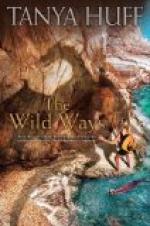[Illustration: “Turning over and over, in one long, sickening dive back to earth”]
A watcher, had there been one, might have seen, just as the last rays of the setting sun touched the steely reaches of the estuary, turning them to lakes of crimson, something, somebody—or bodies, truly, for they were locked together—suddenly appear, streaking down headlong from out the heavens. There followed a single terrific splash far out over the tide, an upheaval of waters, a succession of ripples hurrying outwards, ever outwards, to tell the tale, and then—nothing.
Next morning, as the sun rose, a party of mournfully shrieking black-backed, herring, common, and black-headed gulls were gathered around the soaked and bedraggled carcasses of a polecat and a buzzard, stranded by the falling tide upon a mud spur, and still locked savagely and implacably in death.
Half a mile away, in the darkness of her burrow, the she-polecat stirred uneasily in her sleep, and, waking for a moment, stared out at the still, silent, secret marshes, wondering, perhaps, why her mate had not returned.
And ten miles away, far up in their great nest among the boughs of a mighty Scotch fir, three downy, but already fierce-eyed, buzzard nestlings craned their necks upwards, calling hungrily, and wondering why their mother had not returned; while their father shot and swerved backwards and forwards over the tree-tops, mewing and calling, uneasily and lonelily, to the clouds for his wife, who had so mysteriously disappeared. And so—fate and the end.
This only remains to be said—the female polecat and the male buzzard did, in spite of Fate, manage to rear their young. And if the gamekeeper and the collector, the sportsman and the farmer, have not been too cruel, those young are alive-to-day.
XII
THE FURTIVE FEUD
There was a sun. You could not see it much because of burning, dancing haze, but you could not get anywhere without feeling it. Almost everything you touched—sand, rock, and such like—blistered you; and the vegetation, where it wasn’t four-inch thorns and six-inch spikes and bloated cacti, was shriveled yellow-brown, like the color of a lion. Perhaps it was a lion, some of it. How could one tell?
Lizards, which were bad; and scorpions, which were worse; and snakes, which were worse than worse, lay about in the sun, as if they were pieces of leather drying. You could not see them—which was awkward, for some of them held a five-minute death up their sleeve—partly because they matched their surroundings, partly because they were still. They were colored burnt to hide in a burnt land.




